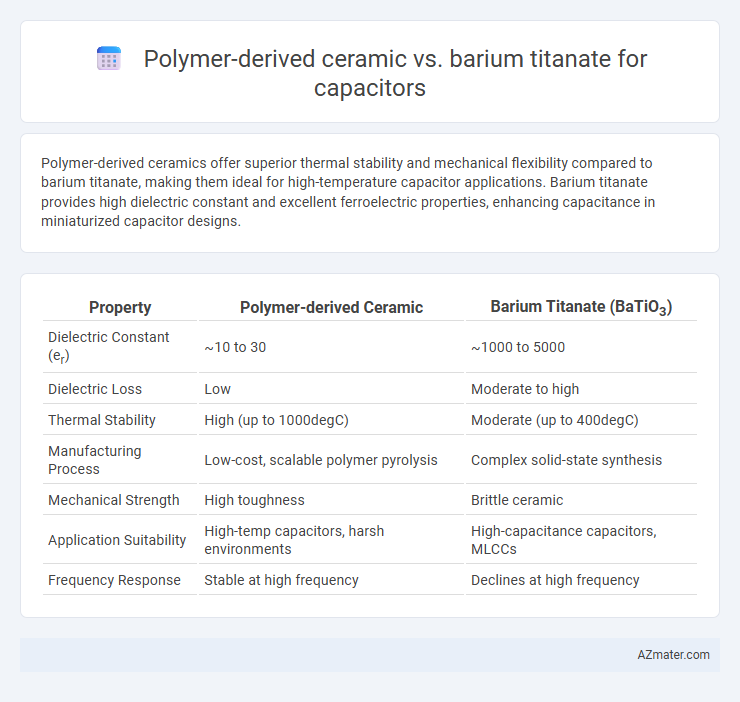Polymer-derived ceramics offer superior thermal stability and mechanical flexibility compared to barium titanate, making them ideal for high-temperature capacitor applications. Barium titanate provides high dielectric constant and excellent ferroelectric properties, enhancing capacitance in miniaturized capacitor designs.
Table of Comparison
| Property | Polymer-derived Ceramic | Barium Titanate (BaTiO3) |
|---|---|---|
| Dielectric Constant (er) | ~10 to 30 | ~1000 to 5000 |
| Dielectric Loss | Low | Moderate to high |
| Thermal Stability | High (up to 1000degC) | Moderate (up to 400degC) |
| Manufacturing Process | Low-cost, scalable polymer pyrolysis | Complex solid-state synthesis |
| Mechanical Strength | High toughness | Brittle ceramic |
| Application Suitability | High-temp capacitors, harsh environments | High-capacitance capacitors, MLCCs |
| Frequency Response | Stable at high frequency | Declines at high frequency |
Introduction to Advanced Capacitor Materials
Polymer-derived ceramics offer superior thermal stability, high dielectric strength, and excellent mechanical flexibility compared to traditional materials, making them ideal candidates for advanced capacitor applications. Barium titanate, a well-established ferroelectric ceramic, exhibits high dielectric constant and tunable permittivity, but often suffers from brittleness and reduced temperature tolerance. Innovations in polymer-derived ceramic synthesis enable enhanced performance and durability in capacitors by combining ceramic-level dielectric properties with polymer-like processing advantages, positioning them as promising alternatives to barium titanate in next-generation capacitors.
Overview of Polymer-Derived Ceramics
Polymer-derived ceramics (PDCs) offer a versatile platform for capacitor applications due to their excellent thermal stability, high dielectric strength, and tunable composition at the molecular level. Unlike barium titanate, a conventional ferroelectric material with a fixed crystal structure, PDCs enable customizable microstructures that improve dielectric performance and mechanical robustness under extreme conditions. The amorphous-to-crystalline transition in PDCs can be precisely controlled, making them attractive for next-generation capacitors in high-temperature and high-frequency environments.
Barium Titanate: Properties and Applications
Barium titanate is a ferroelectric ceramic material known for its high dielectric constant, excellent temperature stability, and strong piezoelectric properties, making it ideal for capacitors in electronic circuits. Compared to polymer-derived ceramics, barium titanate-based capacitors exhibit superior capacitance density and enhanced energy storage capabilities, critical for applications in multilayer ceramic capacitors (MLCCs) and embedded capacitors in advanced microelectronics. Its tunable dielectric properties and reliability under varying electrical and thermal stresses make barium titanate a preferred choice in precision electronics, sensors, and actuators.
Dielectric Performance Comparison
Polymer-derived ceramics exhibit superior thermal stability and mechanical robustness compared to barium titanate, making them more reliable in high-temperature capacitor applications. Barium titanate offers a higher dielectric constant, typically ranging from 1,000 to 10,000, which enables greater energy storage but suffers from temperature-dependent permittivity fluctuations. Polymer-derived ceramics maintain stable dielectric performance over a broader temperature range with moderate permittivity values around 100 to 500, providing enhanced capacitance stability and lower dielectric loss for precision capacitor designs.
Thermal Stability and Reliability
Polymer-derived ceramics exhibit superior thermal stability compared to barium titanate, maintaining dielectric properties at elevated temperatures beyond 800degC, which enhances capacitor reliability under harsh thermal conditions. Barium titanate, while known for its high dielectric constant, suffers from phase transitions around 120degC to 150degC, leading to reduced performance stability and potential degradation in long-term applications. The intrinsic structural robustness of polymer-derived ceramics ensures consistent capacitance and low dielectric loss over extensive thermal cycling, making them preferable for high-reliability, high-temperature capacitors.
Processing Techniques and Scalability
Polymer-derived ceramics offer precise control over microstructure through advanced processing techniques such as pyrolysis and additive manufacturing, enabling uniform thin films ideal for capacitors. Barium titanate, processed predominantly via solid-state sintering and sol-gel methods, benefits from well-established industrial scalability but may face challenges in achieving nanoscale uniformity. Polymer-derived ceramic processing supports integration with flexible substrates and complex geometries, presenting scalability advantages for next-generation capacitor fabrication.
Energy Storage Capabilities
Polymer-derived ceramics exhibit high thermal stability and dielectric strength, enabling superior energy storage density in capacitors compared to traditional materials. Barium titanate offers excellent dielectric permittivity but tends to have lower breakdown voltage and energy efficiency under high electric fields. The enhanced energy storage capabilities of polymer-derived ceramics make them ideal for advanced capacitor applications requiring high power density and long-term reliability.
Frequency Response Characteristics
Polymer-derived ceramics exhibit superior frequency response characteristics compared to Barium titanate in capacitor applications, maintaining stable dielectric properties up to GHz frequencies. Barium titanate, while having a high dielectric constant at low frequencies, suffers from significant dielectric loss and reduced permittivity as frequency increases. The robust thermal stability and low dielectric loss tangent of polymer-derived ceramics enhance performance in high-frequency and high-temperature capacitor environments.
Cost Analysis and Material Availability
Polymer-derived ceramics offer lower raw material costs and easier scalability given their synthetic polymer precursors, enabling more cost-effective production compared to barium titanate, which relies on high-purity, often expensive raw barium and titanium sources. Material availability favors polymer-derived ceramics due to the broader accessibility of polymer feedstocks, whereas barium titanate faces supply chain constraints linked to mining and refining of rare metals. Cost analysis reveals that while barium titanate delivers superior dielectric properties, its higher material and processing expenses contrast with the budget-friendly, widely available polymer-derived ceramics, making the latter more suitable for cost-sensitive capacitor applications.
Future Trends in Capacitor Material Development
Polymer-derived ceramics (PDCs) exhibit superior thermal stability and tunable dielectric properties, positioning them as promising candidates for next-generation capacitor materials. Barium titanate remains a benchmark due to its high permittivity and established manufacturing processes but faces limitations in scaling and temperature sensitivity. Future trends highlight hybrid composites combining PDC matrices with barium titanate nanoparticles to enhance breakdown strength and energy density for high-performance capacitors.

Infographic: Polymer-derived ceramic vs Barium titanate for Capacitor
 azmater.com
azmater.com